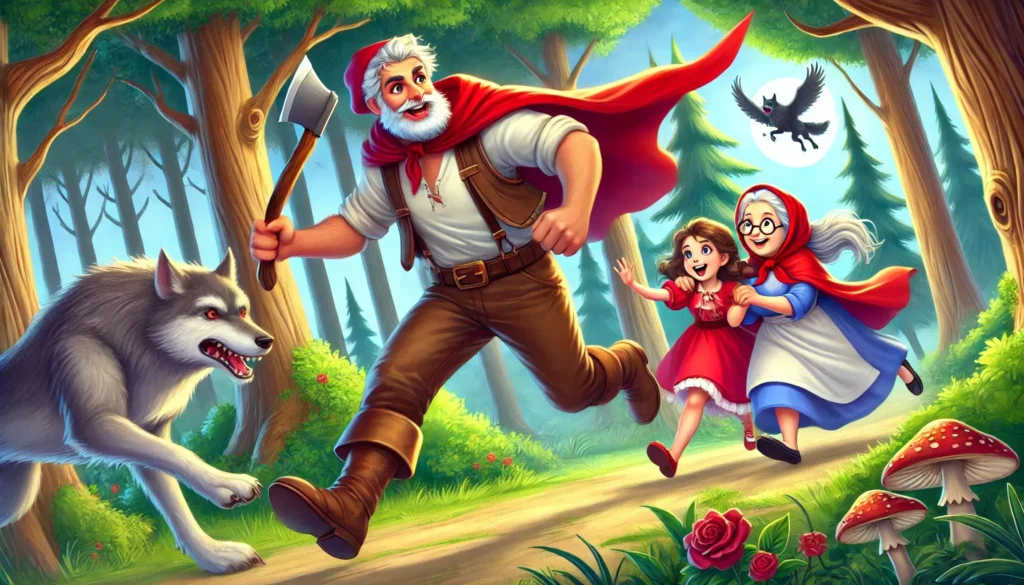The story of Little Red Riding Hood is one of the most enduring fairy tales in Western literature. Passed down orally for centuries before being written by authors such as Charles Perrault and the Brothers Grimm, this tale continues to captivate children and adults alike. On the surface, it is the simple story of a young girl, a cunning wolf, and a grandmother. Yet beneath the narrative lies a rich tapestry of themes including innocence, danger, temptation, and the importance of wisdom.
This article explores the origins, symbolism, plot, themes, and modern adaptations of Little Red Riding Hood, showing why it remains one of the most influential fairy tales in history.
Origins of Little Red Riding Hood
The earliest roots of the story can be traced back to European oral traditions in the Middle Ages. Variants of the tale existed in France, Italy, and other regions before being published in literary form.
- Charles Perrault’s Version (1697)
Perrault’s Le Petit Chaperon Rouge is one of the first written versions. It ends tragically with the wolf devouring both Little Red Riding Hood and her grandmother. Perrault emphasized the moral lesson of obeying parents and being cautious of strangers, particularly for young girls. - Brothers Grimm Version (1812)
In the Grimm brothers’ Rotkäppchen, the story takes on a more hopeful tone. The wolf still deceives and eats Little Red Riding Hood and her grandmother, but a huntsman arrives, kills the wolf, and rescues them. This version highlights redemption and the possibility of salvation. - Global Variants
Similar stories appear in Asian and African folklore, often involving young girls outwitting dangerous animals. These variants show how universal the theme of a vulnerable character encountering danger is across cultures.
Comparative and Superlative: A Complete Guide with Rules and Examples
Summary of the Classic Tale
The plot of Little Red Riding Hood follows a simple but powerful sequence:
- The Mission
A young girl, nicknamed Little Red Riding Hood for her bright red cloak, is sent by her mother to deliver food to her ailing grandmother. She is warned not to stray from the path. - The Encounter
On her way through the forest, she meets a wolf. The wolf cunningly learns of her destination. - The Deception
The wolf reaches the grandmother’s house first, disguises himself in her clothing, and waits in bed for Little Red Riding Hood. - The Climax
The girl arrives and notices something strange about her “grandmother,” leading to the famous exchange:- “What big eyes you have!”
- “The better to see you with, my dear.”
- “What big teeth you have!”
- “The better to eat you with!”
- The Resolution
Depending on the version:- In Perrault’s version, the wolf eats her, and the story ends as a grim cautionary tale.
- In the Grimms’ version, a huntsman rescues the girl and grandmother, cutting open the wolf and saving them.

Symbolism in Little Red Riding Hood
The story is more than a simple tale. It is layered with symbolism that has inspired endless interpretations.
1. The Red Cloak
The color red symbolizes passion, danger, and transformation. It highlights Little Red Riding Hood’s innocence on the brink of maturity.
2. The Forest
The forest represents the unknown, a place of temptation, risk, and self-discovery. It is the threshold between safety and danger.
3. The Wolf
The wolf is the embodiment of deception, temptation, and predatory behavior. In moral interpretations, it symbolizes evil, lust, or manipulation.
4. The Path
The straight path symbolizes obedience and safety. Straying from it implies curiosity, rebellion, or lack of discipline, leading to danger.
5. The Grandmother’s House
While meant to be a safe haven, it becomes a place of danger, reflecting how trust can be exploited by cunning forces.
Themes in Little Red Riding Hood
- Innocence vs. Experience
The tale contrasts childlike innocence with the dangers of the adult world. - Obedience and Disobedience
Little Red Riding Hood’s choice to talk to the wolf or stray from her path is central to the story’s lesson about obeying parents and authority. - Deception and Trust
The wolf uses disguise and charm to exploit the girl’s trust, symbolizing how appearances can be misleading. - Danger of Strangers
The story has long been used to teach children about the risks of speaking with strangers. - Rescue and Redemption
The Grimm version offers a message of hope: mistakes can be overcome, and salvation is possible through courage and outside help.

Moral Lessons from Little Red Riding Hood
The tale teaches several lasting morals:
- Always listen to parents and elders.
- Strangers may appear friendly but have hidden intentions.
- Disobedience can lead to danger.
- Wisdom and courage can overcome evil.
- Appearances can be deceiving.
These lessons remain relevant, especially in teaching young children about safety and caution in a complex world.
Psychological Interpretations
Scholars and psychologists have offered deeper readings of the story:
- Freudian Interpretation: Some view the wolf as a symbol of repressed desires or sexual danger, with the red cloak representing maturity.
- Jungian Interpretation: The tale can be seen as a journey of individuation, where Little Red Riding Hood confronts the darker aspects of life (the wolf) and emerges wiser.
- Feminist Readings: Feminist scholars analyze how the story reflects societal warnings to young women, framing the wolf as a metaphor for male predators.
Modern Adaptations
The timeless quality of Little Red Riding Hood has led to countless adaptations in literature, film, music, and art.
1. Literature
- Angela Carter’s The Company of Wolves offers a darker, feminist retelling.
- Roald Dahl included a witty version in his Revolting Rhymes.
2. Film and Television
- Animated films and cartoons often present a lighter, comedic take on the story.
- Hollywood adaptations such as Red Riding Hood (2011) reimagine the tale as a gothic fantasy.
3. Music and Theatre
- Ballets, operas, and songs have used the story as a base for exploring innocence and danger through performance.
4. Children’s Books
- Simplified and illustrated versions continue to be staples in children’s literature around the world.
Why Little Red Riding Hood Endures
Several reasons explain why this fairy tale has survived centuries of retelling:
- Universal Themes: The struggle between innocence and danger is timeless.
- Adaptability: The tale can be retold for different cultures, ages, and purposes.
- Moral Lessons: Its clear message about safety resonates with parents and educators.
- Symbolic Richness: Scholars and artists find endless layers of meaning.
- Emotional Impact: The suspenseful encounter between girl and wolf captures imaginations of all ages.
Conclusion
The tale of Little Red Riding Hood is more than just a children’s story; it is a mirror of human fears, morality, and growth. From Perrault’s cautionary tale to the Grimm brothers’ hopeful resolution and modern reinterpretations, the story has evolved while retaining its central message: innocence must face danger, but wisdom and courage can lead to survival.
By exploring its origins, plot, symbolism, and adaptations, we see why this fairy tale remains one of the most powerful and enduring in human history. Whether read to children as a bedtime story or analyzed by scholars for its deeper meanings, Little Red Riding Hood continues to be the red thread weaving together tradition, morality, and imagination.


